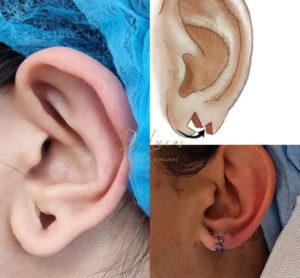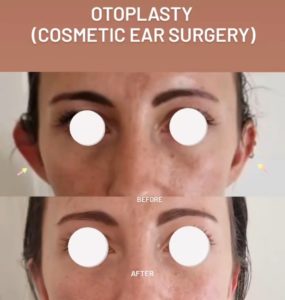This procedure consists of correcting the shape of the earlobe, which may be too large or deformed. We can also repair a tear in the earlobe due to trauma or an elongation of the cleft due to the wearing of heavy earrings. Finally, we can plump up an atrophied earlobe with fat.
Technique:
The procedure is performed under local anesthesia. An aesthetic shape is restored to the earlobe according to the patient’s wishes, avoiding straight scars, but rather Z-shaped scars, thus breaking the tension lines allowing an absence of tension within the scar and thus preventing retractions during healing.
Results:
Time to final results:
2 weeks to see a significant result, 2 to 3 months to see the final result (discreetly pink scar for 1 to 2 months)
Longevity of results :
Definitive
Before surgery:
Smoking must be stopped 1 month before the operation (risk of skin necrosis is important if you smoke)
Do not take Aspirin 10 days before surgery, inform Dr. Lucas of any anticoagulant medication (Sintrom, Coumadin, Eliquis, etc..) to organize its discontinuation or replacement.
Take Arnica capsules 5 capsules 5 times a day for 5 days before surgery to prevent hematoma.
Intervention :
Pain: the pain during the intervention will be almost non-existent, with an adapted anesthesia
Duration of the operation: 45 minutes
Anesthesia: local
Location: operating room
Outpatient
After surgery:
Post-operative pain: 1/10 often responding to Dafalgan
Social eviction: 2-3 days with swelling
Suture removal: 7 days
Return to work: 2-3 days
Return to sport: 3 weeks
Instructions:
Bed rest without major effort (which can cause the opening of small vessels during effort and lead to a hematoma) for 48 hours
Ice for 1 week, as often as possible, to reduce swelling
Arnica capsules 5 times a day for 5 days after surgery to prevent hematoma
Permanent cessation of smoking to prolong the effect of the surgery and minimize complications
Control Dr Lucas D1, D7, 3 weeks, 3 months, 6 months, 1 year
Complications
– Hematoma, infection
– Pain or even localized skin necrosis, responsible for a delay in healing (the risk is increased by smoking intoxication).
Abnormal, hypertrophic or even keloid scars, of unpredictable appearance and evolution, can compromise the aesthetic aspect of the result and require specific local treatments. Regular follow-up is essential.















